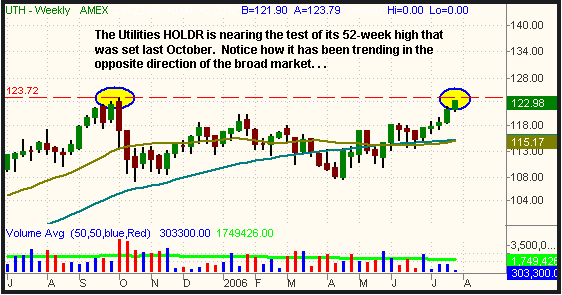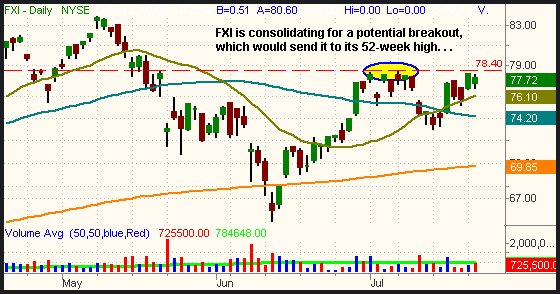A late-day rally saved the indexes yesterday
Early morning strength in the broad
market faded quickly yesterday, sending stocks into negative
territory, but a moderate buying spree into the close pushed the broad market
back towards its intraday highs. Both the S&P 500 and Nasdaq Composite advanced
0.6%, as the Dow Jones Industrial Average gained 0.5%. The small-cap Russell
2000 Index rallied 1.0% and the S&P Mid-cap 400 Index gained 1.2%.
This time, higher turnover helped to confirm the gains in both exchanges. Total
volume in the NYSE increased by 11%, as volume in the Nasdaq was 1% higher than
the previous day’s level. The gains on higher volume made yesterday a bullish
“accumulation day” that hinted at the return of institutional buying activity.
Market internals were positive as well. In the NYSE, advancing volume exceeded
declining volume by a margin of more than 5 to 2. The Nasdaq ratio was positive
by nearly 2 to 1.
In yesterday’s Wagner Daily, we pointed out the relative strength in the
Pharmaceutical sector ($DRG), which broke out of a base of consolidation.
Another sector that recently did the same is the Utilities ($DJU). While the S&P
500 has been trending sideways to lower, the $DJU index has been grinding its
way higher. It is interesting that the sector closed yesterday at its highest
level since October of 2005 because that was the period when the S&P and Nasdaq
were at their lowest levels. As we often see, the Utilities are again acting as
a defensive play for investors who flock to the safety of minimal capital gains
with high dividend levels. All of the Utilities ETFs listed on our ETF Roundup
guide have similar chart patterns, but the Utilities HOLDR
(
UTH |
Quote |
Chart |
News |
PowerRating) is one of
the most well-known ETFs that tracks the sector. The weekly chart below shows
how UTH closed just below its 52-week high that was set last October:

Another ETF that has come onto our radar screen as a potential long entry is the
iShares Xinhua China 25 Fund
(
FXI |
Quote |
Chart |
News |
PowerRating). This ETF, which is kind of like China’s
version of the Dow Jones Industrial Average, corrected along with the U.S.
markets from May through mid-June. However, FXI has been showing relative
strength this month, as it stopped going down when the S&P and Nasdaq did.
Instead, it began to consolidate just above its 50-day moving average. We like
this chart pattern because a breakout above the consolidation will probably
cause FXI to rally to its 52-week high and possibly break it. Regular
subscribers will see our trigger, stop, and target prices for this setup we are
stalking for potential entry. The daily chart below illustrates the setup:

As for the broad market, it is noteworthy that the S&P 500
closed yesterday back above its 50-day moving average. The Nasdaq, however, has
made up little ground and remains near its low. Going into today, expect the S&P
500 to find resistance at its July 3 high of 1,280. The Nasdaq will find major
resistance at the 2,135 area, as it marks convergence of its 50-day moving
average with its primary downtrend line. If either index manages to rally above
those levels, it could generate substantial upside momentum in the markets, but
we continue to treat the gains of the past two days as a bear market bounce
until that happens.
If you’re long, be sure your positions are in the industry
sectors that are showing the most relative strength to the market.
Pharmaceuticals, Healthcare, and Utilities are showing relative strength by
outperforming the market on the “up” days and barely dropping on the market’s
“down” days. The pharmaceutical ETFs may have quite a bit more upside momentum
because the sector has been beaten down for so long. Conversely, anything
tech-related is the sector to avoid or consider selling short into a bounce.
Sector ETF relative strength and weakness will be the topic of our live workshop
that we will be presenting in various cities around the country over the next
two months. Click here for more details. As usual, earnings season has caused a
lot of volatility out there, but the technical patterns will begin working well
again in another week or so, after most of the big names have reported.
Open ETF positions:
Long LQD (regular subscribers to The Wagner Daily receive detailed stop and
target prices on open positions and detailed setup information on new ETF trade
entry prices. Intraday e-mail alerts are also sent as needed.)
Deron Wagner is the head trader of Morpheus Capital
Hedge Fund and founder of Morpheus Trading Group (morpheustrading.com), which he
launched in 2001. Wagner appears on his best-selling video, Sector Trading
Strategies (Marketplace Books, June 2002), and is co-author of both The
Long-Term Day Trader (Career Press, April 2000) and The After-Hours Trader
(McGraw Hill, August 2000). Past television appearances include CNBC, ABC, and
Yahoo! FinanceVision. He is also a frequent guest speaker at various trading and
financial conferences around the world. For a free trial to the full version of
The Wagner Daily or to learn about Deron’s other services, visit
morpheustrading.com or send an e-mail to deron@morpheustrading.com .
